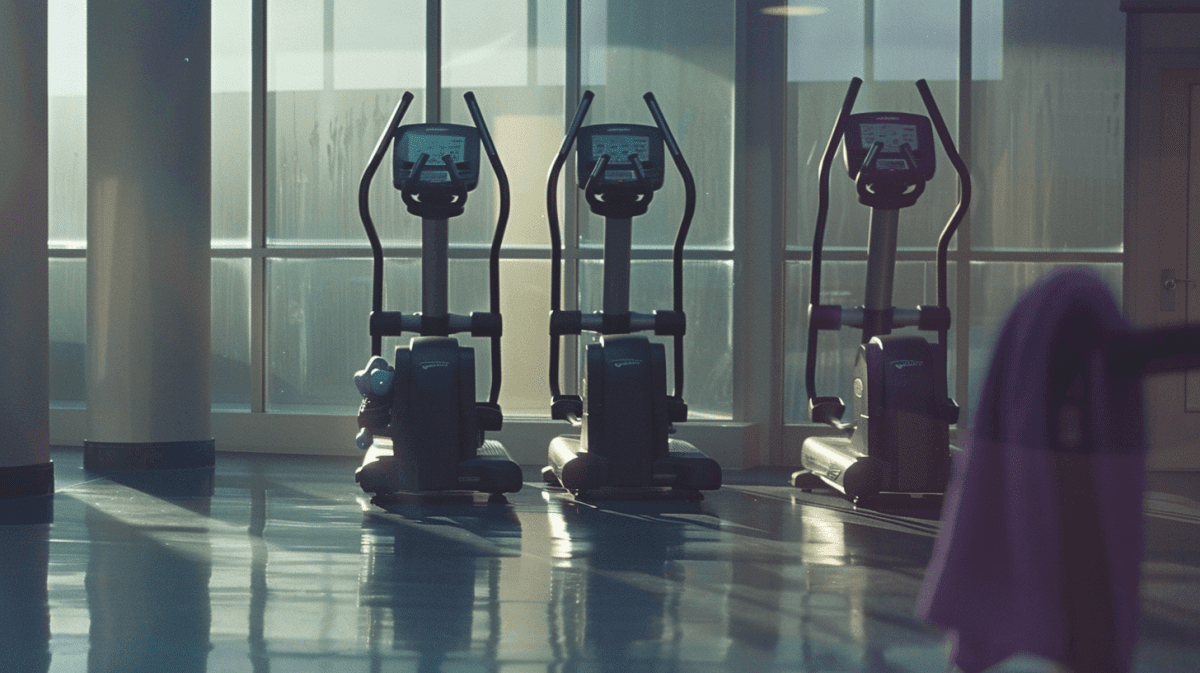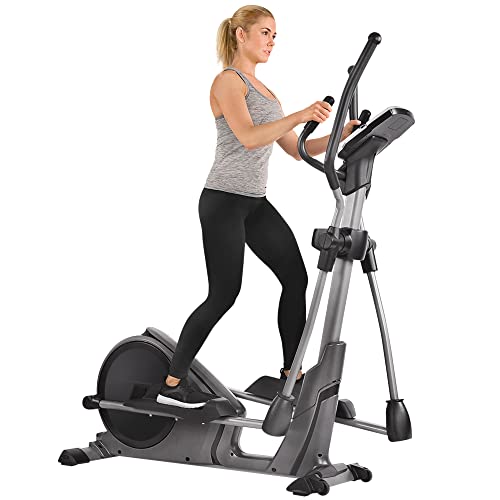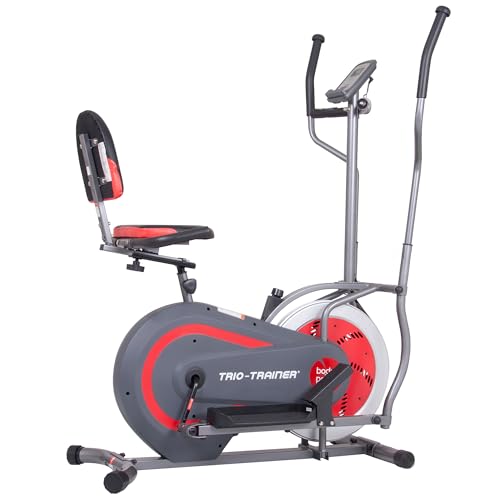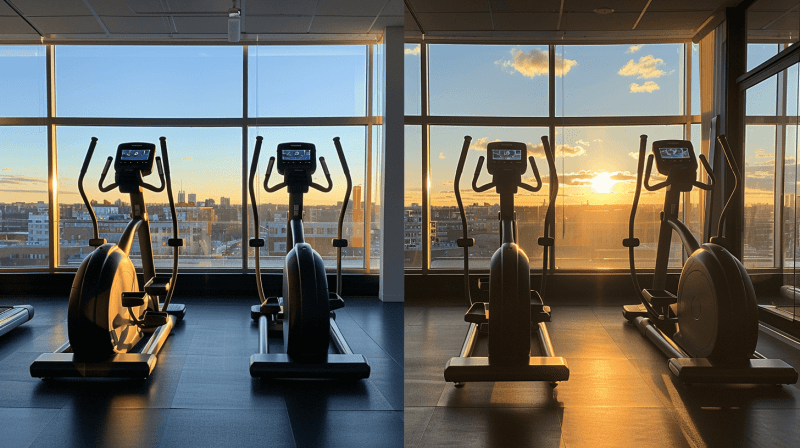Studies show that 25% of gym-goers regularly use the elliptical machine as their primary form of cardio exercise. If you're considering joining their ranks, you'll want to know exactly how often you should hop on this popular piece of equipment. While the machine's low-impact nature makes it tempting to use daily, the ideal frequency depends on several key factors, including your current fitness level, weight loss goals, and overall exercise routine. Understanding the right balance between training days and recovery can mean the difference between achieving your fitness goals and hitting a frustrating plateau.
Key Takeaways
-
Beginners should start with 2-3 days per week for 15-20 minutes per session to allow proper adaptation to elliptical training.
-
Standard recommendation is 5 sessions per week for 30 minutes each, totaling 150 minutes of moderate-intensity cardio.
-
Weight loss goals require 5 sessions per week for 45-60 minutes each, targeting 500-1,000 calories burned per session.
-
Advanced users can train 5-7 days weekly, alternating between HIIT and steady-state cardio with 1-2 rest days.
-
Cross-training with strength exercises and low-impact activities should be incorporated between elliptical sessions for optimal results.
Understanding the Elliptical Machine
While many gym-goers are familiar with treadmills, the elliptical machine offers a versatile and joint-friendly alternative for cardiovascular exercise. This form of exercise combines the natural movements of walking or running with the low-impact benefits of stationary training. You'll find that elliptical machines provide a thorough cardio workout while minimizing stress on your ankles, knees, and hip joints.
The elliptical machine's design features movable handles and foot pedals that create a fluid, oval-shaped motion. When you're using the machine, you'll engage both your upper and lower body simultaneously, making it an efficient full-body workout option. The rear-drive design offers the smoothest and most natural stride pattern for users. This dual-action movement helps improve your cardiovascular health while building muscular endurance in multiple muscle groups.
For those new to cardiovascular exercise, the elliptical serves as an excellent starting point. You'll discover that elliptical workouts can be easily adjusted to match your fitness level, allowing you to gradually increase intensity as your stamina improves. The machine's digital display typically shows essential metrics like speed, distance, and calories burned, helping you track your progress and maintain consistent workout intensity. The machine's forward-backward motion is generally preferred over an up-down movement pattern for optimal exercise benefits.
Health Benefits and Safety
Regular exercise on the elliptical machine offers substantial health benefits when you follow recommended guidelines. As a cardiovascular exercise machine, the elliptical aligns with Physical Activity Guidelines for Americans, helping you burn calories while protecting your joints from high-impact stress. You'll meet the American Council on Exercise recommendations by maintaining 30-minute sessions five days per week, which supports ideal heart health and weight management. The low-impact nature of elliptical workouts makes it an excellent choice for those with joint concerns or recovering from injuries.
To guarantee you're getting the most from your Workout to Sculpt Stronger muscles while staying safe, you'll want to balance intensity with recovery. The health benefits are most pronounced when you follow a structured approach: aim for 150 minutes of moderate-intensity aerobic exercise spread across your week.
If you're targeting weight loss, you can safely increase this to 250 minutes weekly through 45-60 minute sessions.
For perfect safety and effectiveness, you shouldn't use the elliptical every day. Instead, incorporate 2-3 lower-intensity sessions into your weekly routine, allowing your body adequate recovery time. This approach helps prevent overuse injuries while maximizing the cardiovascular and muscular benefits of your workouts.
Using the elliptical at least three times per week can help reduce bad cholesterol levels within 3-6 months of consistent exercise.
Recommended Weekly Training Schedule
To maximize your elliptical workouts, you'll want to follow a structured weekly schedule that balances intensity with recovery. The ideal frequency for most adults is using the elliptical 5 days per week, which helps improve cardiovascular health and supports weight loss goals while allowing adequate rest periods.
You can structure your weekly schedule in two effective ways:
-
Standard Schedule: Use the elliptical for 30 minutes per session, 5 days per week. This approach helps you meet the recommended 150 minutes of moderate-intensity cardiovascular exercise while maintaining consistency in your routine.
-
Progressive Schedule: If you're focusing on weight loss, increase your sessions to 45-60 minutes, 5 days per week. This extended duration helps you burn more calories and achieve the recommended 250 minutes of weekly exercise for enhanced weight management.
Strength training exercises should be incorporated into your weekly routine to boost lean muscle mass and enhance fat loss. To prevent overtraining, incorporate 2-3 lower-intensity days into your schedule. You can adjust the intensity of your elliptical sessions based on your fitness level and goals. For example, alternate between high-intensity days (40-60 minutes) and moderate-intensity days (20-30 minutes) to maximize your results while allowing proper recovery. Using interval training techniques during your workouts can further enhance calorie burn and boost your overall metabolism.
Beginner Workout Guidelines
Starting your elliptical journey requires a different approach than the full weekly schedule described above. If you're new to using an elliptical trainer, begin with two to three times per week to allow your body to adapt to this form of cardiovascular exercise. This moderate frequency helps prevent overexertion while building your fitness foundation.
For ideal results as a beginner, follow these key guidelines:
- Start with 15-20 minute sessions at a comfortable pace
- Maintain proper form by keeping your back straight and grip relaxed
- Gradually increase duration before adding HIIT workout elements
As your endurance improves, you can work toward the recommended five days per week schedule for enhanced weight loss and cardiovascular benefits. Listen to your body during this progression, and don't hesitate to take additional rest days when needed.
Remember that short, low-intensity sessions on the machine can supplement your primary workouts while maintaining proper recovery periods. The key to successful elliptical training lies in consistent progression rather than immediate intensity, allowing your body to build strength and stamina safely over time.
The gliding motion design of elliptical machines reduces joint impact and lowers injury risk compared to other cardio exercises.
Weight Loss Exercise Plans
Success in weight loss comes from combining effective elliptical workouts with proper planning. To lose weight effectively, you'll need to use the elliptical for approximately 300 minutes per week, which translates to about 60 minutes per session, five days a week. This consistent schedule helps your body burn more calories while improving your overall health and heart health.
For prime weight loss results, structure your weekly plan around these key components:
- Schedule five hour-long sessions throughout the week
- Aim to burn 500-1,000 calories per session through varied intensity
- Incorporate HIIT workouts twice weekly to maximize calorie burn
- Maintain steady-state cardio sessions on other days
Your elliptical training should combine both high-intensity intervals and moderate-pace workouts to keep your body challenged. When you're working to lose weight, consistency is vital - missing sessions can dramatically impact your results. Track your calories burned during each session and adjust your intensity as needed. Remember that your success depends on maintaining both your exercise schedule and proper nutrition, as the combination creates the caloric deficit necessary for steady weight loss.
Advanced Training Frequency
The advanced elliptical training schedule demands a significant increase in weekly workout frequency, ranging from 5-7 days per week. This higher intensity approach allows you to maximize the number of calories burned while incorporating both steady-state cardio and HIIT sessions.
The elliptical allows for thorough upper body engagement when you actively use the handles during your workouts.
To optimize your advanced training, monitor these key aspects:
- Maintain your target heart rate within 70-85% of your maximum during intense sessions
- Alternate between HIIT days and moderate-intensity steady-state cardio
- Include at least one active recovery day at lower intensities to prevent overtraining
As an experienced user of exercise equipment, you can safely progress to daily workouts while varying your intensity levels. Your body's adaptation to frequent training enables you to handle more volume, but you'll need to pay attention to recovery signals. Track your performance and energy levels, adjusting your schedule if you notice persistent fatigue. Remember that the elliptical's low-impact nature supports this higher training frequency, making it an ideal choice for intensive cardiovascular conditioning.
Rest and Recovery Principles
Proper rest and recovery from your elliptical workouts stands out as one of the most essential elements for long-term progress. Your muscles need adequate time to repair and strengthen between sessions, particularly after high-intensity training. To prevent overtraining, you'll want to incorporate 1-2 rest days per week into your exercise routine.
During your recovery periods, you don't need to remain completely inactive. Cross-training with low-impact activities like swimming or cycling can help maintain your fitness while giving your primary muscle groups time to recuperate. These alternative exercises work different muscle patterns while reducing the risk of repetitive strain.
Pay close attention to your body's fatigue signals to optimize your recovery schedule. If you're experiencing persistent muscle soreness or decreased performance, you might need additional rest days. You can also implement active recovery sessions, where you use the elliptical at a lower intensity (around 50-60% of your maximum effort) to promote blood flow without overtaxing your system. This approach helps maintain your fitness routine while giving your body the necessary time to rebuild and adapt to your training demands.
Combining With Other Exercises
Beyond standalone workouts, integrating elliptical training with complementary exercises creates an all-encompassing fitness program that targets multiple aspects of your health. Combining your elliptical workouts with strength training and resistance exercises helps build muscle mass while maintaining the cardiovascular benefits of cardio training.
To maximize your fitness results, you'll want to guarantee these effective exercise combinations:
- Alternate between elliptical sessions and strength training days to promote muscle recovery while maintaining consistent activity
- Incorporate low-impact exercises like yoga to improve flexibility and reduce the risk of injury from repetitive motions
- Include resistance training on non-elliptical days to boost metabolism and enhance weight loss results
The key to success lies in proper exercise scheduling and maintaining a balanced diet. You'll want to space out your different activities throughout the week, allowing adequate recovery time between intense sessions. If you're unsure about creating a suitable routine, consulting a fitness professional can help you develop a personalized program that incorporates elliptical training alongside other exercises for maximum effectiveness. This approach ensures you're targeting all aspects of fitness while preventing overtraining.
Long-term Training Success
Maintaining long-term success with elliptical training requires a strategic balance between consistency and adaptability. For ideal results, you'll want to aim for five days a week of elliptical workouts, spending at least 30 minutes per session at moderate-intensity aerobic levels. This frequency allows your body to adapt while preventing overtraining, which can derail your progress.
To sustain your fitness journey, you'll need to adjust your routine based on your evolving fitness level and goals. While it might be tempting to use the elliptical every day, incorporating rest days is indispensable for recovery and performance. When you're exercising, focus on maintaining enough resistance to challenge yourself while preserving proper form.
As you progress, consider varying your workout intensity and duration. Health Publishing suggests that you can maximize results by combining different forms of cardio with your elliptical training. Track your progress by monitoring improvements in your endurance, the amount of weight you can lose, and your overall fitness gains. If you're unsure about your training frequency or intensity, consulting with a fitness professional can help you develop a sustainable long-term plan.
Frequently Asked Questions
How Many Days a Week Should You Do Elliptical?
You'll get excellent cardiovascular fitness improvement by using the elliptical 5 days weekly. For best results, adjust intensity levels between sessions and include rest days to maximize calorie burn and prevent overtraining.
Is It Safe to Use an Elliptical Everyday?
You shouldn't use the elliptical every day, as your body needs rest to recover. For ideal safety and results, limit your workouts to 3-5 times weekly, allowing rest days between sessions.
Is Elliptical Good for Losing Belly Fat?
Yes, elliptical workouts effectively target belly fat through low-impact cardio sessions. You'll see best results combining high-intensity intervals with 30-minute sessions, 4-5 times weekly, while maintaining a calorie deficit through healthy eating.
Is It Better to Go Faster or Longer on an Elliptical?
You'll benefit from both approaches. High intensity intervals with shorter durations burn calories quickly, while moderate resistance settings and longer durations build endurance. Mix both styles to maximize results and engage your whole body.
Conclusion
Remember, Rome wasn't built in a day, and neither is your fitness journey. You'll get the most benefit from your elliptical training by matching your weekly frequency to your current fitness level - starting with 2-3 sessions as a beginner and potentially working up to 5-7 sessions for advanced users. Listen to your body, allow proper recovery time, and you'll develop a sustainable routine that helps you reach your fitness goals safely and effectively.







